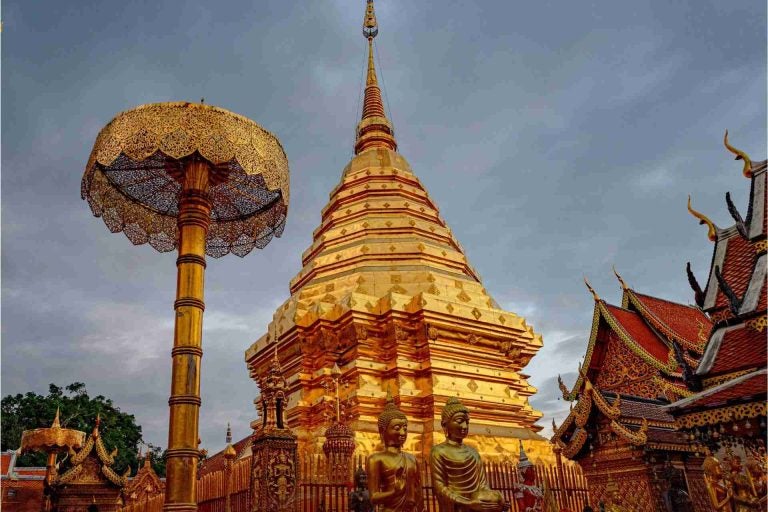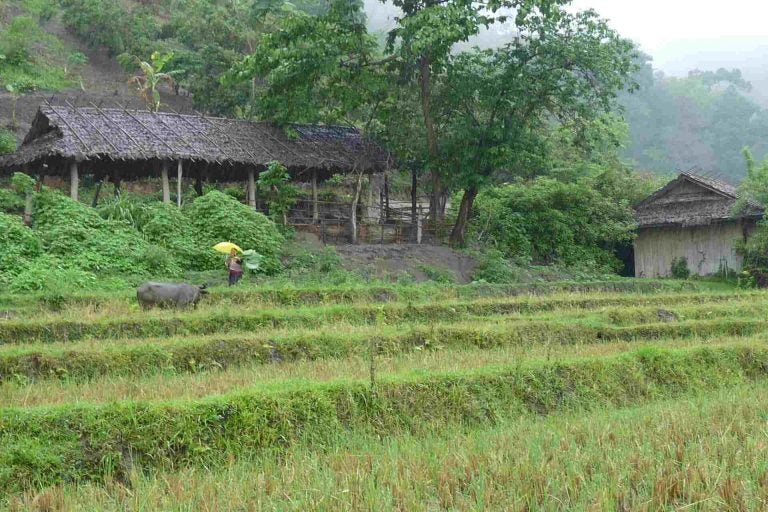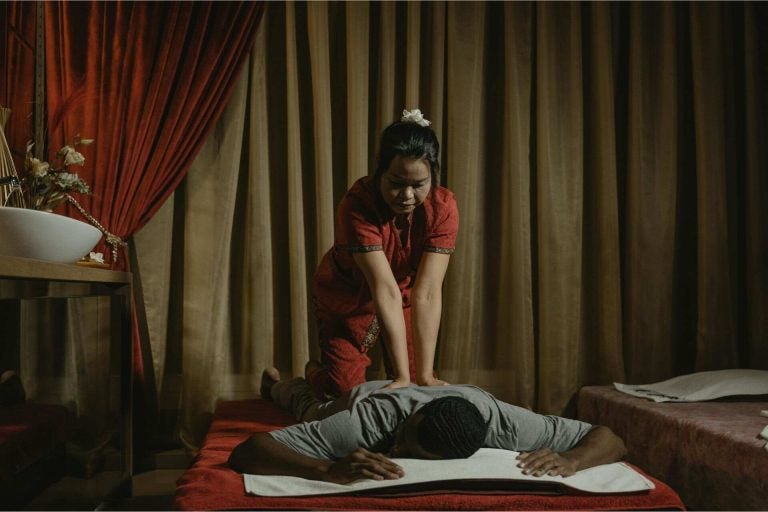12 best things to do in Chiang Mai
Visiting Chiang Mai soon? Follow along for a list of the best activities in the region, including national parks, temples, food experiences, and more.
Want to have the full Thailand experience but don’t feel like dealing with the crowds of Bangkok? A visit to Chiang Mai might just be in the books for you. The mountain city in northern Thailand is one of the biggest in the country, yet it has a small-town charm while offering plenty of things to do and places to visit.
It’s also a hub for digital nomads in Thailand, gathering people from all over the world who enjoy this type of lifestyle. As a result, it became a place of startups, business networking, and collaboration.
Follow along for a list of the best things to do in Chiang Mai and surrounding areas as well as some tips to help you make the most of your experience here.
1. Go temple hopping
Chiang Mai is home to some of Thailand’s most beautiful and historically significant temples. And with them being located within walking distance from one another, temple-hopping is an activity you won’t want to miss when visiting the city.
Wat Phra Singh, located on Ratchadamnoen Road in the Old City, is one of the most famous, known for its stunning golden stupa (a dome-shaped Buddhist shrine) and the revered Phra Singh Buddha statue. It’s easily accessible by foot from most places in the Old City.
Wat Chedi Luang, just a short walk from Wat Phra Singh, is another one you won’t want to miss. This ancient temple features a massive, partially ruined chedi that dates back to the 14th century and offers a glimpse into the grandeur of the city’s past.
For a more serene experience, head to Wat Chiang Man on Ratchaphakhinai Road, the oldest temple in Chiang Mai. It houses significant historical artifacts, including ancient Buddha images.
Wat Suan Dok is yet another one you won’t want to miss. It is located on Suthep Road, about 2 km from the Old City. It’s known for its large collection of white chedis and is home to Chiang Mai University’s monk training program.
If you don’t feel like walking, catching a tuk-tuk from one temple to the next is a great option.
Holafly tip:
When visiting temples, dress modestly and make sure to wear clothing that covers your knees and shoulders. You may also need to take off your shoes to enter the temple.

2. Visit the Wat Phra That Doi Suthep temple
While we’re on the topic of temples, Wat Phra That Doi Suthep is well worth your time, even if it’s a bit outside of the Old City. Located on Doi Suthep Mountain, about 15 kilometers (9 miles) from the city, this sacred site is one of the most important religious monuments in all of Thailand.
The temple is famous for its golden stupa, which houses a relic of the Buddha, and its panoramic views of Chiang Mai and the surrounding mountains.
To reach Wat Phra That Doi Suthep, you can take a taxi from the city or rent a scooter for a more adventurous ride, though be prepared for winding narrow roads. The trip from Chiang Mai should take around 30 minutes. Once you arrive, you’ll need to climb 309 steps up a beautiful serpent staircase or take an elevator for a small fee.
While at the temple, take time to admire the architecture, including the golden stupa and surrounding statues. The site is also a great spot for quiet reflection or meditation while enjoying the views of the city below you.

3. Explore the night markets
The Sunday night market, also known as the Sunday Walking Street Market, is one of Chiang Mai’s most vibrant attractions. It takes place along Ratchadamnoen Road every Sunday from 4:00 PM to midnight. Chiang Mai Night Bazaar is another popular night market, taking place Monday to Friday starting at 5:00 PM.
Since the markets are located in Chiang Mai’s Old City, they’re within walking distance from most local attractions. If you’re staying further away, you can take a tuk-tuk to the entrance near the Tha Pae Gate.
Once there, you’ll find hundreds of stalls selling everything from handmade crafts and artwork to delicious street food. The vast selection includes traditional Lanna handicrafts, wooden carvings, silver jewelry, clothing, and vibrant textiles. The food stalls are the real highlight, though. Taste everything from grilled meats and spicy curries to sweet Thai desserts and refreshing drinks.

4. Discover the Doi Inthanon National Park
If you’re willing to explore the Chiang Mai region outside of the Old City, a visit to Doi Inthanon National Park should be on your list of things to do. Located about 2 hours away from the city, the park is home to Thailand’s highest peak, Doi Inthanon, which stands 2,565 meters tall.
Some of the park’s highlights include the King and Queen Pagodas — two beautifully decorated pagodas built to commemorate the 60th birthdays of King Bhumibol Adulyadej and Queen Sirikit. You can also enjoy scenic hikes, like the Kew Mae Pan Nature Trail, which combines Thailand’s iconic lush vegetation with breathtaking mountain views.
Wachirathan Waterfall is another tourist favorite, perfect for photos or a refreshing dip. The park is also home to diverse wildlife and bird species, making it a paradise for birdwatchers.
You can get to Doi Inthanon National Park by taxi, renting a car, or booking a guided tour. That said the guided tour is the best option for most, as it takes you to the top attractions and help you make the most of your day without wandering around aimlessly at the park.

5. Merge with the wildlife at Elephant Nature Park
Chiang Mai and its surrounding areas are home to a number of elephant sanctuaries, each of them worth a visit. The Elephant Nature Park, located about 60 kilometers (37 miles) north of Chiang Mai, is the most popular choice. While admittedly a bit touristy, it allows you to get close and personal with the elephants without breaking any ethical boundaries.
Once at the park, you can spend the day feeding, bathing, and walking with the elephants while learning about the elephant conservation efforts in Thailand. It’s an experience that emphasizes compassion and education, making it one of Chiang Mai’s top attractions for animal lovers.
Once again, taking a tour from Chiang Mai is the best choice, as it includes transportation and a tour guide which ensures an optimal experience without any unnecessary headaches.
Holafly tip:
Avoid any sanctuaries that offer riding, feeding, or otherwise interacting with animals. Being near them is a thrilling experience, but some “sanctuaries” take advantage of the animals and force them to work rather than protect them.

6. Take a Thai cooking class
Food is an essential part of Thai culture, and Chiang Mai is a hub for food lovers. Take a cooking class when you visit Chiang Mai for a first-hand foodie experience. These classes teach you how to prepare traditional dishes using fresh, local ingredients while offering a deeper understanding of Thai flavors and cooking techniques.
Many cooking schools offer market tours, where you’ll visit one of Chiang Mai’s many markets to pick out ingredients before heading back to the kitchen to cook. The classes are typically beginner-friendly, and you’ll learn to make traditional northern Thai food like pad Thai, khao soi, som tam, or mango sticky rice.
In general, food in the north tends to be more mild and less spicy than in the south. This makes any traditional northern Thai dish a good choice if you don’t handle spice very well. Most of these classes take small groups and have a fairly intimate setting, so you’re sure to receive individual attention and tips about Thai cuisine, all while meeting like-minded people.

7. Immerse in local gastronomy
Don’t feel like cooking the food yourself? Don’t rob yourself of tasting the delicious food in northern Thailand, and make sure to visit local restaurants and street food stalls throughout your stay in Chiang Mai.
The local highlights include:
- Khao Soi: a rich, coconut-based curry noodle soup.
- Sai Ua: a flavorful northern Thai sausage made with minced pork, herbs, and spices.
- Nam Prik Ong and Nam Prik Noom: spicy chili dips served with fresh vegetables and sticky rice.
- Mok Pa: a type of fish curry steamed in banana leaves.
Wash it down with some Thai tea, something that’s considered part of the culture and not just a beverage in Thailand.
Holafly tip:
Tap water is not considered safe for consumption in Thailand. So avoid having ice in your drinks or drinking water that doesn’t come from a sealed bottle.

8. Climb the sticky waterfalls
The Bua Thong Waterfalls, also known as the Sticky Waterfalls, is a natural attraction located about 45 kilometers (28 miles) north of Chiang Mai. The limestone deposits on the falls create a “sticky” surface that allows you to climb up the waterfall without slipping, which almost feels like you’re defying the laws of physics.
Once at the waterfalls, you can explore several tiers of cascades, with the lower levels being the easiest to climb. The cool, clear water is a great refreshment on a hot day, while the surrounding area is lush with tropical vegetation synonymous with Southeast Asia.
It’s roughly a one hour drive to get there from Chiang Mai, and you can take a taxi, rent a car, or join a guided tour. That said, a visit to the waterfalls doesn’t require much local knowledge, so taking a tour might not have as much of an impact on your experience as some other things on this list.

9. Take a hill village tribe tour
The hustle and bustle of Chiang Mai may make it seem like that’s how life always was in Thailand. However, a short tour outside of the city to the remaining native tribes is enough to give you a glimpse into what life was like here in years gone by.
There are several hill tribe village tours that leave from Chiang Mai. During a single day, you’ll visit Akha, Hmong, Karen, Lahu, Lawa, Lisu, and Mien groups, also referred to as Chao Khao, meaning hill/mountain people in Thai.
During the visit, you’ll learn about local crafts, cuisine, and farming techniques. You’ll also be able to try local food or buy handmade souvenirs directly from the locals. The experience is a cultural eye-opener that supports sustainable tourism and helps preserve the heritage of these communities.

10. Get a traditional Thai massage
When in Rome, do as the Romans do. You probably know the saying. Well, getting a Thai massage while in Thailand is a must, and not doing it can be considered self-sabotage of your own Thailand experience.
Unlike Western-style massages that focus on kneading muscles, a traditional Thai massage uses the hands, elbows, forearms, and feet to apply pressure to specific points along energy lines on the body. It’s considered to be a healing art in Thailand and is known for its ability to restore balance, relieve stress, and boost circulation.
Chang Mai has no shortage of spas and parlors, each offering massages, with prices ranging from budget-friendly to quite expensive. The massages typically last 60 to 90 minutes and are accompanied by relaxing sounds and smells, enhancing the overall experience.
Whether you’re looking to relax after a day of sightseeing or seeking relief from muscle stiffness, a Thai massage in Chiang Mai is a must-try.

11. Ride the jungle zipline
Add some excitement to exploring the natural beauty of northern Thailand is by taking a jungle zipline adventure in Chiang Mai. Ziplining through the lush jungle canopy offers a bird’s-eye view of the surrounding forests, rivers, and mountains.
Several companies in Chiang Mai, such as Flight of the Gibbon and Chiang Mai Zipline, offer ziplining tours that take you through some of the region’s most stunning landscapes.
The zipline courses typically include a series of platforms connected by cables. Along the way, you’ll pass over vibrant jungle flora, waterfalls, and streams. All while enjoying the adrenaline rush of flying through the air. Most tours also include a nature walk or a brief educational session about the local ecosystem and wildlife.

12. Chiang Mai City Arts and Cultural Center
Located in the heart of the Old City, the Chiang Mai City Arts and Cultural Center provides a look into the region’s rich history, culture, and art. Located in a colonial building that was once the royal court, the center offers great way to learn about Chiang Mai’s evolution from its ancient Lanna Kingdom roots to the modern-day.
The museum features a range of exhibits, including multimedia presentations, historical artifacts, and interactive displays that cover various aspects of Chiang Mai’s past. From the founding of the city to its role as a hub for trade and religion. Exhibits highlight the cultural diversity of the region, with sections dedicated to Lanna art, architecture, and traditional crafts.
The center also hosts temporary exhibitions, cultural performances, and workshops. All in all, the Chiang Mai City Arts and Cultural Center is a must-visit for history buffs, art lovers, and anyone interested in learning more about the city’s heritage.
Tips for visiting Chiang Mai
Now that you have you Chiang Mai itinerary set up, we’d like to share some tips that may make your trip to Thailand even more memorable:
- November to February offers cooler, more pleasant weather. That said, farmers start burning their fields in January in preparation for a new season, which causes a lot of smoke, making November and December the best time to visit Chiang Mai. June to October offer cheaper accommodation and flight tickets, but be prepared for rain and heat.
- Dress modestly, especially when visiting religious sites. Make sure to have something that covers your shoulders and knees when packing your bags for Thailand.
- Respect the Buddha. Religion is an important part of Thai culture, and touching Buddha statues is seen as a sign of disrespect. So admire the statures, but avoid touching them. It’s also illegal to take a statue of Buddha out of Thailand without an export license, and even getting a tattoo of the buddha is considered to be disrespectful.
- Be respectful to elders. While you should respect your elders wherever you go, Thai culture puts an emphasis on it, and so should you when visiting the country.
- Take your time. There are enough things to do in Thailand to keep you occupied forever. Don’t expect to see all of Chiang Mai in a day. 3-4 days are enough to cover the bare basics, while 5-7 weeks allow a more relaxed schedule.
- Many small businesses don’t take cards, so having cash on hand in a must. Whether it’s paying for goods at the market, tipping your tour guides, or buying street food, make sure you exchange some Thai Baht for your trip.
- Stay connected. Having mobile internet in Thailand is a must, and using eSIMs is the most convenient way to stay connected, beating options such as travel SIM cards or data roaming. It allows you to find your way around with map apps, communicate with locals using translators, or simply share holiday snaps with loved ones back home.
Get a Holafly eSIM for Thailand
Looking for the best eSIM in Thailand? Look no further than Holafly. For as little as $1.55/day, you can get unlimited data and solid coverage throughout the country. Dedicated apps for iOS and Android make the service easy to use, while the 24/7 customer support team is ready to help you out in case you encounter any issues or questions.





 Language
Language 


















 No results found
No results found














